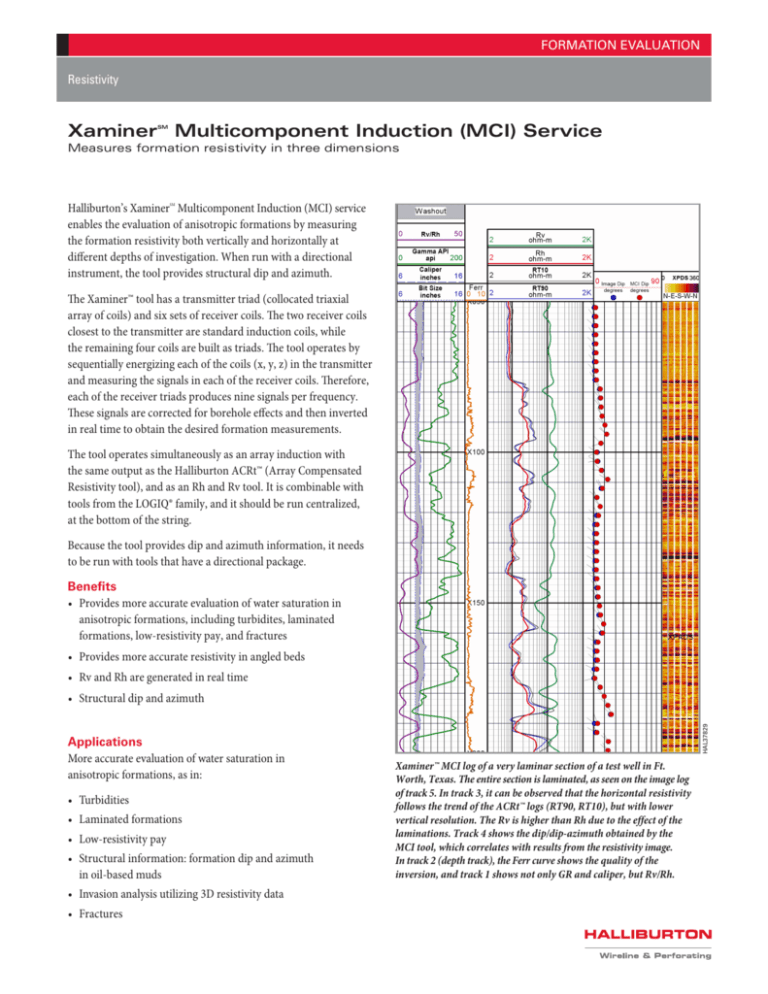
FORMATION EVALUATION
Resistivity
Xaminer Multicomponent Induction (MCI) Service
SM
Measures formation resistivity in three dimensions
Halliburton’s Xaminer Multicomponent Induction (MCI) service
enables the evaluation of anisotropic formations by measuring
the formation resistivity both vertically and horizontally at
different depths of investigation. When run with a directional
instrument, the tool provides structural dip and azimuth.
SM
The Xaminer™ tool has a transmitter triad (collocated triaxial
array of coils) and six sets of receiver coils. The two receiver coils
closest to the transmitter are standard induction coils, while
the remaining four coils are built as triads. The tool operates by
sequentially energizing each of the coils (x, y, z) in the transmitter
and measuring the signals in each of the receiver coils. Therefore,
each of the receiver triads produces nine signals per frequency.
These signals are corrected for borehole effects and then inverted
in real time to obtain the desired formation measurements.
The tool operates simultaneously as an array induction with
the same output as the Halliburton ACRt™ (Array Compensated
Resistivity tool), and as an Rh and Rv tool. It is combinable with
tools from the LOGIQ® family, and it should be run centralized,
at the bottom of the string.
Because the tool provides dip and azimuth information, it needs
to be run with tools that have a directional package.
Benefits
• Provides more accurate evaluation of water saturation in
anisotropic formations, including turbidites, laminated
formations, low-resistivity pay, and fractures
• Provides more accurate resistivity in angled beds
• Rv and Rh are generated in real time
Applications
More accurate evaluation of water saturation in
anisotropic formations, as in:
• Turbidities
• Laminated formations
• Low-resistivity pay
• Structural information: formation dip and azimuth
in oil-based muds
• Invasion analysis utilizing 3D resistivity data
• Fractures
HAL37829
• Structural dip and azimuth
Xaminer™ MCI log of a very laminar section of a test well in Ft.
Worth, Texas. The entire section is laminated, as seen on the image log
of track 5. In track 3, it can be observed that the horizontal resistivity
follows the trend of the ACRt™ logs (RT90, RT10), but with lower
vertical resolution. The Rv is higher than Rh due to the effect of the
laminations. Track 4 shows the dip/dip-azimuth obtained by the
MCI tool, which correlates with results from the resistivity image.
In track 2 (depth track), the Ferr curve shows the quality of the
inversion, and track 1 shows not only GR and caliper, but Rv/Rh.
FORMATION EVALUATION
Xaminer™ MCI Specifications
Standard
Length
Maximum Pressure
Outside Diameter
54.25 in.
Electronics
DeepSuite
206.31 in. (524.03 cm)
20,000 psi (137.9 MPa)
30,000 psi (206.8 MPa)
3.875 in. (9.84 cm)
4.438 in. (11.27 cm)
Maximum Temperature
Weight
Logging Speed
300°F (149°C)
275 lb (125 kg)
336 lb (152 kg)
60 ft / min (0.31 m/s)
Borehole
Mud Type
Oil, Air, Fresh
Minimum
4.75 in. (12 cm)
Maximum
20 in. (51 cm)
206.31 in.
152.07 in.
Sonde
HAL37828
03.875 in.
For more information, contact your local Halliburton representative.
© 2015 Halliburton. All rights reserved. Sales of Halliburton products and services will be in accord solely with the terms and conditions contained in the
contract between Halliburton and the customer that is applicable to the sale.
H09310 12/15
www.halliburton.com










